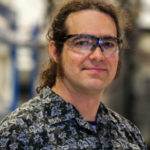Geotechnical Centrifuge – Principle
Posted on August 1, 2023 Geotechnical Instrumentation & Equipment Design
Geotechnical centrifuges offer a convenient way to model processes driven by self-weight, e.g. self-weight consolidation, groundwater flow, or the behaviour of natural/artificial slopes, retaining, and buried structures. Small-scale models of a full-scale scenario (prototype) are spun in a centrifuge at many times Earth’s gravity. Similitude in self-weight stress between the model and prototype is maintained by setting the ratio of the centrifugal acceleration to gravity equal to the ratio of the prototype to model height.
Coanda uses geotechnical centrifuge testing for self-weight consolidation modeling of treated or raw tailings deposits, simulating long-term consolidation behaviour of deep deposits. The time required for testing is inversely proportional to the square of the centrifugal acceleration. This means that a centrifuge can simulate a process that may take many years in a tailings pond in a few hours of centrifuge spinning.
The short testing time allows the behaviour of many tailings samples treated with different processes to be studied, e.g. to assess various tailings disposal options. With a relatively fast turnaround, the small-scale geotechnical centrifuge can also evaluate the consolidation performance of treated tailings on an ongoing basis in the field, provide feedback on the process, and identify anomalies in tailings treatment operations.
As with any model, differences between a model in a centrifuge and prototype consolidating under gravity must be considered. Centrifugal acceleration in a centrifuge varies radially and is directed toward the axis of rotation. Thus, the model self-weight stress is nonlinear in the vertical direction and has a lateral component. However, with proper model design, these issues can be minimized. Similarly, particle segregation at high spin speeds can also be a concern but can be mitigated with appropriate measures, e.g. limiting speeds, multistage spins, or initial consolidation under gravity.



